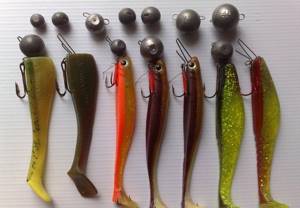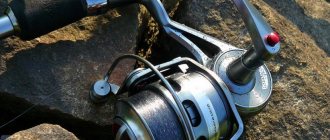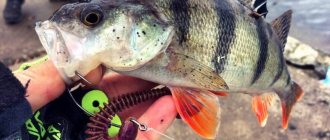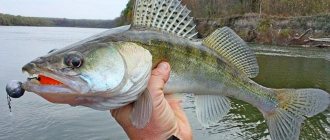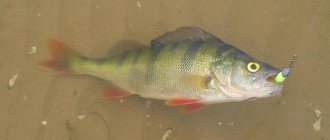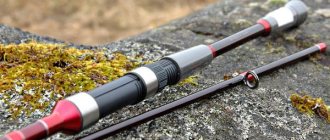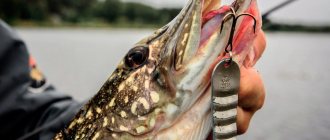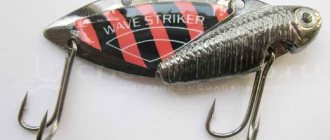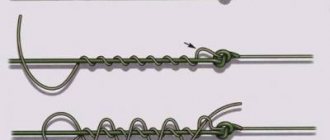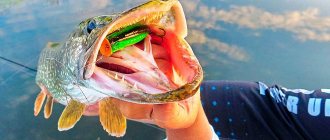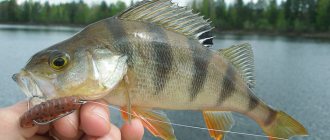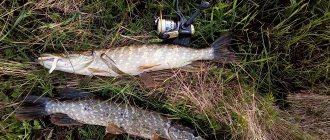Jig is a separate type of spinning fishing, which uses special jig baits and special methods of wiring them. Jig has received powerful development in connection with the beginning of the production of silicone baits. The main baits in jigs are silicone and foam rubber imitations of predator food items. The bait is mounted on a jig head or hook, with an eared sinker attached to it. Jigs are used to successfully catch most predatory fish that live in the bottom layers of reservoirs: pike, pike perch, perch, bass, and catfish. There are a large number of different jigs, the most popular of which is the jig step.
In our publication, we will give recommendations on choosing a spinning rod, reel and fishing line suitable for jig fishing, talk about jig baits, and analyze all the main types of wiring used in jigs.
What is a jig
Jig, as a type of spinning fishing, got its name due to the similarity of the movement of the bait in the water with an ancient British dance of Celtic origin called the jig. Just like the ancient dance, the lure's movement consists of twitching, bouncing and rhythmic swaying.
Jig wiring came to us from abroad about 25-30 years ago, although attempts to fish with this method and develop appropriate baits had been made by our fishermen before.
Currently, jig fishing has firmly established itself among domestic spinning anglers and has become one of the most popular methods of spinning fishing.
The main advantage of jig fishing is the ability to catch the bottom part of the reservoir, where most of the predatory fish are located. It is almost impossible to fish this layer of the reservoir with other spinning baits and fishing rods.
Jig fishing is carried out throughout the open water season. Many anglers continue to fish with jigs even in winter, in those reservoirs where the water is not covered with ice.
Jig fishing can be carried out at any depth, both in still water and in currents of any strength. This fishing method requires a bottom that is clear of underwater vegetation and snags, preferably with hard soil. However, even in reservoirs cluttered with snags and driftwood, anglers can fish with jigs using baits equipped with non-snagging rig options.
Jig can be divided into several categories depending on the weight of the load used with the bait:
- nanojig - with a load weight of up to 1 gram
- microjig - with a load weight from 1 to 7 grams
- light jig - with a load weight of 7 to 21 grams
- medium jig - with a load weight of 21 to 42 grams
- heavy jig - with a load weight of 42 grams and above
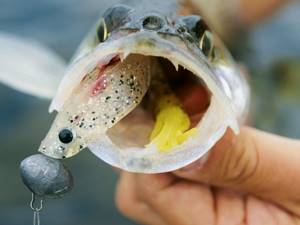
Jig fishing can be carried out either with a bait mounted on a jig head and a hook attached to a Cheburashka weight, or with spaced lead rigs, which include: a lead rig, a Carolina rig, a Texas rig and a drop shot.
The jig fishing technique is relatively simple and can be easily mastered by beginners in this type of fishing on their first trips to a body of water, so jig fishing can be recommended for beginner spinning anglers.
Advantages and disadvantages of a jig-rig
There is nothing magical or extremely catchy about a jig-rig, as many say. Each installation has both advantages and disadvantages, and only a correct understanding of them and the disclosure of positive qualities to the maximum gives a good result.
ADVANTAGES
- an interesting game of bait and a great flight of fancy for animation with dragging along the bottom and at the lowest horizon from it;
- range is a very big plus for coastal fishing;
- maneuverability of the equipment, the jig-rig is less susceptible to snags.
- quick change of weight and bait - the clasp allows you to quickly select the weight and suitable bait.
FLAWS
- fasteners, swivels - all these are weak elements in the equipment when catching trophy fish - you should use good, high-quality fittings;
- vibrating tails play worse and are served less accurately than on a jig head;
- a non-fixed and chaotic position of the hook increases idle bites and makes it worse to spot fish.
This video can be called an encyclopedia of jig-rig. It describes in great detail all the nuances, pros and cons of this equipment, and discusses wiring options.
Spinning for jig
The rod is the main element of spinning tackle. The success of fishing largely depends on how correctly the spinning rod is selected for specific fishing conditions. A spinning rod for jigging must be durable, light in weight, and provide high sensitivity. Spinning rods differ in the material from which they are made, test, action and length.
Spinning material
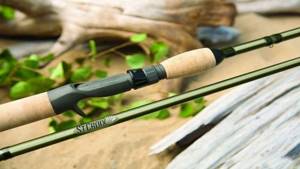
Modern spinning rods for jigging have high demands on strength, weight and sensitivity. Spinning rods can be made of different materials, but spinning rods for jig fishing should be made of carbon fiber. Only carbon fiber rods meet all the requirements. Carbon fiber is the most modern of the materials used for the manufacture of spinning rods. Carbon fiber for spinning rods is also called carbon and graphite. Carbon fiber spinning rods have low weight, good rigidity and high flexibility. The properties of a carbon fiber spinning rod depend on the modulus of the graphite content. The higher the modulus of the graphite from which the spinning rod is made, the more rigid and sensitive the rod will be, but at the same time more fragile, requiring more careful handling.
Spinning test
The spinning test is the manufacturer's recommended weight for the baits cast with this rod. The spinning test is indicated on the form in grams or ounces. When designating a spinning test, two values are indicated: the minimum weight of the bait that can be thrown by this rod and the maximum weight of the bait that can be thrown by this spinning rod without overloading the rod blank.
For jigging, rods with different tests are used. In most cases, jigging uses ultralight class spinning rods with a test weight of 0.5-3 grams, light class spinning rods with a test weight of 5-12 grams, and middle class spinning rods with a test weight of 15-40 grams. Rods for heavy jigs with 40 grams of dough are used much less frequently; they are designed for fishing at great depths and strong currents.

When choosing a test rod for jig, you should proceed from the weight of the bait used when fishing, and it depends on the depth of the reservoir, the presence and speed of the current. The fall of the jig bait to the bottom should be clearly felt by the rod blank.
Spinning rods for jigging of the ultralight class, with an upper test limit of 5-6 grams, are used by experienced fishermen for fishing on small rivers and reservoirs with standing water.
Light-class jigging spinning rods, with a test weight of 5-12 grams, are considered the most universal; they are well suited for beginners in jigging.
The same can be said about spinning rods for middle-class jigs, with a test weight of 7-28, 5-35 grams. Such rods allow you to fish most places accessible both from the shore and from a boat.
Heavy class jigging spinning rods, with an upper test limit of 50-60 grams, are designed for fishing in deep holes on large rivers with strong currents. They are used by anglers who already have some experience in jigging.
The spinning rod must be suitable for the weight of the jig baits used. When fishing with a jig, the tip of the spinning rod should bend moderately under the weight of the bait and play back. The spinner must use the tip of the rod to determine both the bottom and the bite. If you put a jig head weighing 5 grams on a spinning rod with a top weight of 60 grams, it will be impossible to catch quality fish.
Spinning rod length for jig
Spinning rod manufacturers produce spinning rods in a variety of sizes designed to catch a wide variety of fish in a variety of conditions. European manufacturers of spinning rods measure the length of spinning rods in meters, American manufacturers traditionally indicate the length of spinning rods in feet and inches.
Most spinning rods have a length from 160 to 360 cm. The longer the spinning rod, the longer the cast can be made with it, but as the length of the spinning rod increases, its weight increases and its maneuverability decreases.
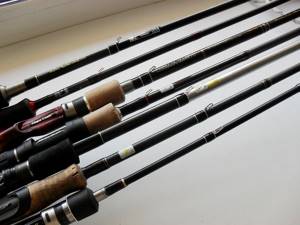
The choice of spinning rod length for jigging depends on whether the fishing will be done from the shore or from a boat.
For jigging from the shore, you should use spinning rods with a length of 2.7 to 3.3 meters; such rods allow you to cast bait over a long distance. In addition to a greater casting range, a longer rod allows you to more conveniently control the bait, feel the bite, make a high-quality hook at a long distance and land fish.
When fishing with a jig from a boat, where the casting distance is not significant, it is more convenient to use a spinning rod with a length of 2.1 to 2.4 meters.
You may be interested in: Kukan
Spinning rod structure
The structure of a spinning rod is the most important characteristic of a fishing rod. The casting distance and sensitivity of the spinning rod depend on the rod's structure.
Action is the ability of a rod blank to bend under load. The closer the spinning rod's action is to fast, the stiffer it is and the higher its sensitivity, the better all the vibrations are transmitted to the angler's hand, but as the rigidity of the spinning rod increases, the casting range of the bait decreases.
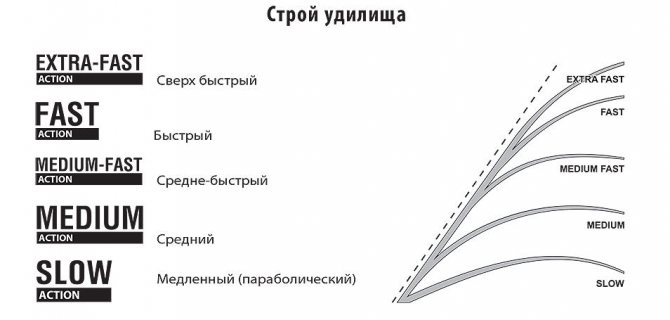
Based on the action, there are spinning rods of super-fast, fast, medium and slow action. Ultra-fast and fast-action rods are well suited for jigging.
Extra Fast
– only the very tip of the spinning rod bends, no more than ¼ of the length of the rod. An ultra-fast spinning rod is well suited for twitching and jig fishing. Ultra-fast spinning rods have maximum sensitivity, but have a shorter casting range and are less effective at softening the jerks of fish when playing.
Fast formation
– under load, the spinning rod bends from half the length of the rod. Fast action spinning rods are also mainly used for twitching and jigging.
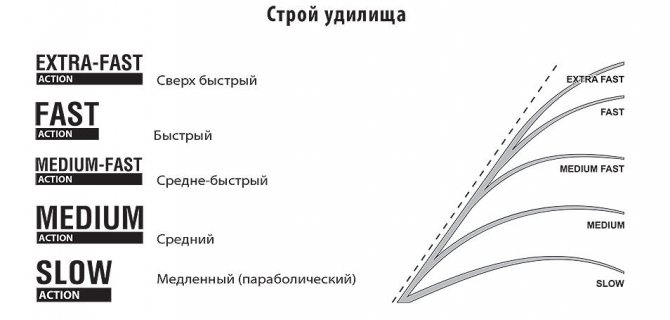
Fast and ultra-fast spinning rods have maximum sensitivity; they allow maximum control over the movement of the bait in the water, feel the bait touching the bottom, and transmit the most careful fish bites to the angler.
Rigid fishing rods with fast and super-fast action allow you to force fish near snags, bushes and stones, and also make it possible to hook fish well at a long distance when the line bends under the influence of the current or wind.
Passing rings
Jig fishing is most often done using braided lines, which create increased friction in the guides of the rod. High-quality guide rings not only hold the cord, but also ensure minimal friction between the ring and the fishing line.
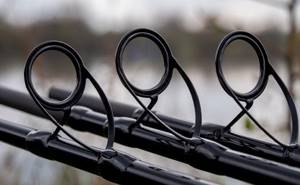
The material from which the rings are made plays an important role. The rings are of poor quality; from constant friction of the fishing line or cord against the ring, grooves form on the rings. Rings with such grooves literally wear out the fishing line in just a few casts and rewinds, which breaks during the next cast and the bait is shot. The best rings for spinning rods intended for jigging today are rings with inserts made of Alconite (black) and SIC (gray).
Spinning - selection criteria
It should be immediately noted that jig heads have their own weight, which can vary from units to tens of grams. Therefore, special requirements are imposed on spinning rods that are incomprehensible to beginning spinners. Spinning is chosen based on 3 main criteria - length, test and sensitivity. With the right choice, the spinner will always feel the bait and react to the bite in time.

Length
The length of the rod is selected depending on the fishing conditions: when fishing from the shore, which does not have serious thickets, a rod up to 3 meters long is suitable. When fishing in places where there are thickets, you won’t catch much with a long rod and it is better to use a shorter rod, for example, 2.4 m long. When fishing from a boat, you can use the shortest rods, and they will be the most effective.
Test
A very important indicator, but for a beginning spinning angler, when he has not yet learned how to cast the tackle correctly, far and accurately, a rod with a weight of up to 45g is suitable. After mastering the jig technique, you can purchase another rod, with a test weight of up to 15g, for using small jig baits.
Sensitivity
The spinning rod must be sensitive, otherwise it will not be possible to react to a bite in time. The components of the sensitivity of a spinning rod are: the structure of the rod and how much the test corresponds to the weight of the jig bait used. If you use small jig baits on rods with a large dough, then you can hardly talk about the sensitivity of such gear, since you won’t even feel the presence of bait on the gear.
Jig reel
When fishing with jigs, anglers most often use spinning reels. The most versatile reel for jig fishing is a spinning reel with a front drag in size 2000-3000. The size of the reel must correspond to the spinning test: ultralight - 1000, small - 2000, medium - 3000.
Experienced fishermen often use multiplier reels when fishing with heavy jigs, but for beginner spinning anglers they are too difficult to master and a little expensive.

When jigging, reels are subjected to quite serious loads, the main part of which affects the transmission mechanism, so it is desirable that the gears and shafts are made of high quality materials and with maximum precision.
When fishing with a jig, high-speed retrieves are not required, so it is better for the reel to be high-torque rather than high-speed. The optimal gear ratio of the coil is from 4 to 5.
When fishing with a jig, it is desirable that the reel has a good friction brake with precise adjustment. This brake makes it much easier to catch, especially large fish.
Jig line
A high-quality braided line is one of the main components of successful jig fishing. When fishing with a jig, the angler must feel the most careful bites, the bottom topography, and the movement of the bait in the water. All this can only be provided by a braided cord, which has minimal elongation and therefore ensures high sensitivity of the gear.
Braided cord does not have high durability, it wears out with use and is more expensive than regular monofilament. Thanks to minimal stretch, the braided cord perfectly conveys the angler’s manipulations when retrieving, making the animation of the bait look more realistic. When using braided fishing line, the bite is instantly transmitted to the rod, even at a considerable distance.
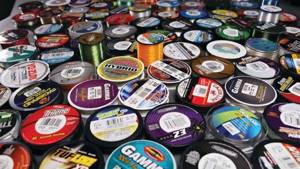
A good braided line should have a cross-section close to round, a tight weave and a smooth surface. When choosing a braided fishing line, you should not save money; choose high-quality products from well-known manufacturers.
Jigs can use braided lines with diameters ranging from 0.06 mm to 0.2 mm, but the most commonly used lines are 0.1-0.14 mm in diameter. The thickness of the braided line used should correspond to the test of the rod, the capacity of the spool, the weight of the bait and the weight of the intended fish.
The color of the braided line does not play a significant role; many anglers use brightly colored fishing line for jig fishing, contrasting with the color of the water, which makes it possible to visually control the rewinding of slack lines during fishing.
Regular monofilament is practically not used in jig fishing. At close range fishing, monofilament performs well, especially when fishing, but due to the high stretch coefficient, which also increases when wet, it does not provide good sensitivity and is poorly suited for retrieving and hooking.
Leash
When purposefully catching pike with a jig, anglers must use leashes. Also, the use of a leash is highly desirable where catching a pike is very likely.
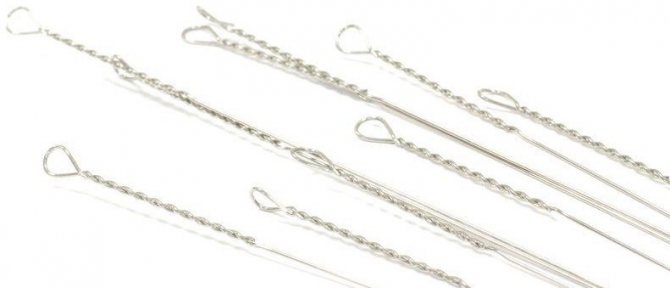
Leashes can be made from different materials:
- Braided metal cables, different sections, from different materials
- Single metal string
- Fluorocarbon leader
Metal leashes often reduce the number of pike perch bites, so if you are specifically fishing for pike perch, you will either have to stop using a leash altogether or use a fluorocarbon leash. The diameter of the fluorocarbon leader should be 0.45-0.6 mm. The leash is of a thinner diameter, the pike easily bites. The pike does not pay any attention to the leash, no matter what material it is made of. Leashes must have high-quality carabiners, fasteners and swivels.
Jig baits
Classic jig involves fishing with soft silicone baits mounted on jig heads. Soft silicone baits have the general shape of a small fish and can be found in a variety of colors. A soft silicone bait on a classic jig head is the most versatile bait, suitable for catching any predator in any conditions. In addition to jig heads, soft silicone baits are often used with a swivel mount, which is an offset hook or double attached to a weight with two eyes, which anglers call Cheburashkas. In addition to classic silicone baits, so-called foam fish are used in jigs. They are mounted using a hinged mounting. Foam fish are especially effective in catching pike perch.
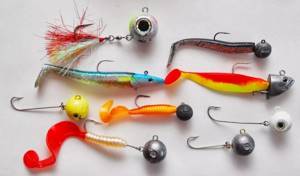
In addition to silicone and foam baits, jigging can use rotating and oscillating spoons, which can be driven with jigging lines.
An angler should have jig baits of different sizes and colors in his arsenal. During the fishing process, if there are no bites on the bait within 30-40 minutes, try replacing it with a bait of a different size, type or color. Change baits often.
Jig sinkers should be present in the angler's arsenal in different weights and shapes. While fishing, the angler should be able to experiment with different weights in 2 gram increments.
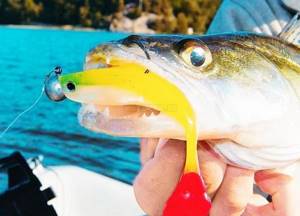
Before fishing with any jig bait, you should test it for behavior in water, installation method and wiring. It is best to do this in clear water, in the shallows, so that the angler can see the behavior of the bait with his own eyes.
When fishing with a certain bait, you should remember what kind of living object it resembles to a predator. For example, crayfish crawl along the bottom, sometimes rising above it, so when fishing with a silicone crustacean, you should drag it along the bottom, with slight twitching of the rod tip.
You may be interested in: Sunline Small Game PE Braided Cord
Silicone baits
Silicone baits are the most common type of bait used in jigging. It was the appearance of soft silicone baits that gave birth to the very principle of jig fishing.
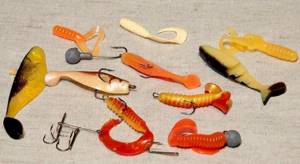
Since the appearance of the very first silicone baits, a lot of time has passed and during this time a huge number of different types of silicone baits have been created, but all of them can be divided according to their shape into three large groups:
- Vibrating tails
Have the shape of a small fish, equipped with a tail, at the end of which there is a special element called a hoof. Vibrating tails create lower frequency vibrations in the water than twisters. - Twisters
Silicone baits consisting of a body and a long ribbon tail twisted with a screw . The twister game is created by the movement of the bait's tail. When the bait moves in the water, the twister creates high-frequency vibrations, reminiscent of a wounded fish. - Other
In addition to vibrotails and twisters, silicone baits can be in the form of worms, various insects, crustaceans, shrimp, larvae, octopuses, and cuttlefish. Silicone baits of this type are used to catch not only predators, but also peaceful fish: bream, crucian carp, rudd, carp.
All three groups of baits catch fish well; you should not give preference to only one of them; they should all be present in the angler’s arsenal.
Silicone baits can be of various sizes from 0.5 to 20 cm. The size of the bait when fishing is selected depending on the size of the intended prey. For catching perch, lures are usually used 2 inches (5 cm) long, for catching pike perch 3-3.5 inches (7-9 cm) long, for pike 3-4 inches (97-10 cm) long. The most universal size of silicone baits is from 2.5 to 3.5 inches.
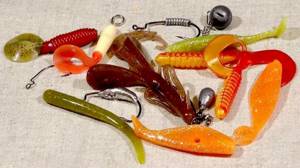
Silicone baits can come in a variety of colors. Many silicone baits have sparkles and fluorescents added to them, which makes the bait more attractive to predators. There is no single catchable color; the angler must have in his arsenal silicone baits of different colors: acidic (bright green, yellow, orange), solid dark (black, brown, dark purple), white and translucent. The color of the bait is selected experimentally on the pond.
Silicone baits are divided into edible and inedible. Manufacturers add attractants and flavorings to the composition of edible rubber, giving them certain smells and tastes that additionally attract fish.
The main targets for fishing with silicone are: pike, pike perch and perch; sometimes peaceful fish can also be caught: bream, rudd, carp and crucian carp.
Foam rubber fish
Foam rubber fish were born much earlier than silicone baits, but they are still very catchy jig baits. When catching a passive predator, foam rubber can even outperform silicone baits.
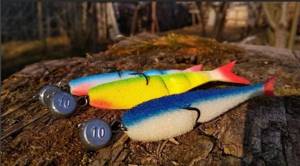
To make a foam fish, dense foam rubber is used, from which a thin shape, like a fry, is cut out with scissors. Most often, foam fish are shaped like a cigar or an elongated drop. The cut out foam rubber fish can be painted with markers in the color desired by the fisherman, and also soaked in a concentrated liquid attractant.
Recently, many manufacturers of fishing lures have mastered the production of foam rubber fish and now fishermen do not have to make them themselves; they can immediately buy ready-made ones.
Foam rubber fish are usually mounted on a double hook attached to an eared weight. Foam rubbers are especially effective when catching pike perch. The wiring of the foam rubber is no different from the wiring of silicone baits.
Mandula
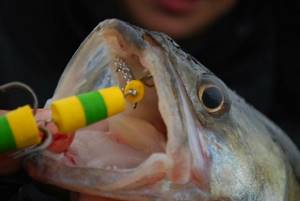
A relatively new jig bait, it is a hinged structure of 2-5 polyurethane foam segments, contrasting colors, with hooks in each or some of them. It was originally invented for catching passive pike perch, but later it turned out that it also works well for pike and large perch. The mandula is made of polyurethane foam, has positive buoyancy, and when fishing it stands on the bottom in a vertical position, held by a weight. When manipulating the reel and rod, it swings from side to side, attracting a predator. Fishing with a mandula is possible in a place that is clear of snags and stones, otherwise, due to the many hooks of the mandula, there will be many snags.
Jig baits
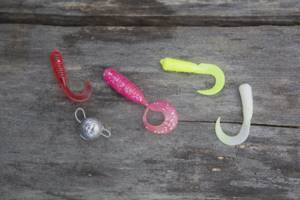
Twisters and a sinker weighing 4 grams. They are connected into a ready-made jig rig using an offset hook. The eye can be easily pulled out of the sinker, so you can assemble the equipment without a winding ring.
The use of jig baits makes it possible to hunt any predator, regardless of the type of reservoir, depth, in the current or in its absence. They can fish even the most difficult places: snagged, rocky and overgrown with vegetation.
The main thing is to follow the rules for equipping such baits for each specific case.
Depending on the game, jig baits are classified into:
- Active (vibrating tails, twisters), which are in particular demand among Russian spinning fishermen.
- Passive (all possible variations of exotic living creatures in the form of lizards, crustaceans, mollusks, etc.), with which you can also catch white fish.
To make fishing effective, you should choose the right size, color and material of the jig bait.
To provoke a large predator to bite, you should select a large bait and vice versa. So, a bait with a size of 10-13 cm is suitable for pike, a bait of 7-9 cm should be used for pike perch, and 3-6 cm for perch.
If the bait is made of soft material, then the game will be quite active and lively. But given the structure of such a product, it will not last long (it will not withstand bites from the teeth of a predator).
If it is a bait made of hard material, then the product will not lose its qualities, despite the injuries received during the fishing process, but it will be difficult to attract the object of the hunt.
They produce jig baits in a wide range of colors: from brightly aggressive to naturally calm.
In sunny weather, it is recommended to use natural colors, and in cloudy weather, brightly saturated shades.
The most popular type of jig baits are vibrating tails , which imitate live fish. They can be in both narrow and wide forms.
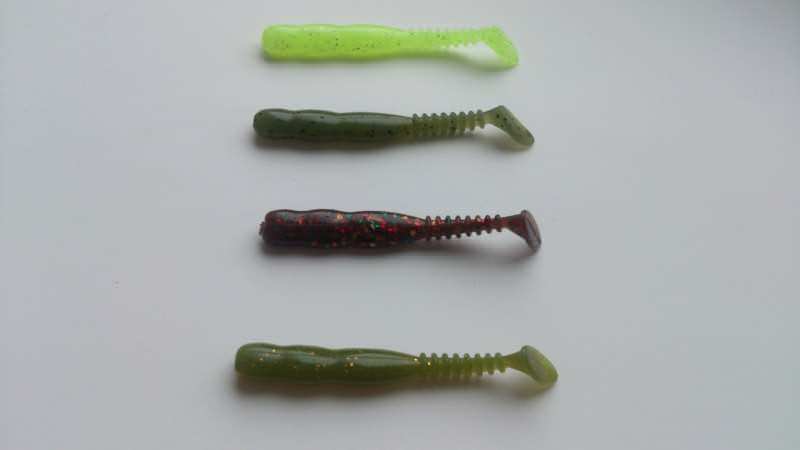
Vibrating tails for jig fishing, made by hand by pouring silicone into molds
Methods for mounting jig baits
Classic jig head
The classic jig head is a lead weight with a hook rigidly soldered into it, so the weight and hook are a single unit. A silicone bait is put on the hook, and the tip of the hook is brought out. Due to the rigid connection of the hook and the weight, the classic jig head hooks fish better.
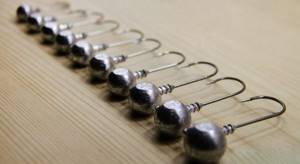
The most common jig heads are spherical in shape; they are considered the most versatile, suitable for any fishing conditions. Flat heads of the “iron” are used for fishing on a snag bottom, as they have better maneuverability. Rugby jig heads have an elongated shape and do not fall on their side when retrieved, which increases the chances of a successful hookup.
The main criterion by which a jig head is selected is its weight. The smallest jig heads can weigh 1 gram. The most common jig heads weighing from 5 to 28 grams. An angler should have in his arsenal jig heads of various weights so that he can choose a jig head for specific fishing conditions.
Hinge rig with open hook
The hinged rig is a weight with two eyes, called a Cheburashka by fishermen, with an offset or double hook attached to it. The hook is attached to the weight-Cheburashka using either winding rings, or is put on a free clasp pulled out from the weight. A silicone or foam bait is put on the hook, and the tip of the hook is brought out.
Hinge-free equipment
When using a hinged rig with a Cheburashka weight, the tip of the offset hook may not come out, but be hidden in the body of the silicone bait. This installation allows you to fish in the strongest places with a large number of hooks, but at the same time it is much worse to cut through the fish when hooking.
Spaced lead rigs
Spaced lead rigs are rigs in which the hook and bait are not directly connected to the load. Spaced lead rigs are used for specific fishing conditions: when fishing in strong places, when catching passive fish, if necessary, to deliver bait over a long distance.
Lead jig rigs typically use either sliding bullet weights or drop, cigar, or cone-shaped swivel weights.
There are several options for spaced lead rigs:
- A retractable leash,
also called the Moscow rig, is an installation in which the main fishing line is tied to a three-sided swivel, to the other ears of which a sinker on a 20-30-centimeter leash and a leash 1-1.5 m long with a hook and a silicone bait at the end are tied. - A drop shot is an installation in which a sinker is attached to the end of the main line, and a hook with a silicone bait is tied 40-90 cm above the sinker, directly to the line.
- The Carolina rig
is a special installation in which the main fishing line is threaded through a sliding sinker in the form of a bullet or olive, and a 0.5-1.5 m long leash with a silicone bait is attached to it through a swivel. - The Texas rig
is a special rig consisting of: a silicone bait, a bullet weight, a single or offset hook and a limiter bead. The Texas rig is designed for catching predators in bodies of water overgrown with vegetation.
Jig wiring
Posting a jig bait can be done by reeling it in with a reel or pulling it with a spinning rod, or both. A jig bait can move in the water along a variety of trajectories: evenly or stepwise, with or without touching the bottom.
You may be interested in: Minnow: characteristics, size, color, wiring, tips, photos, videos

There are a large number of different jig postings. The use of a particular fishing line by a fisherman depends on the specific body of water, the intended catch, fishing conditions, and the degree of fish activity. If one jig does not work, you need to try another. If you have tried several runs and there is no result, you should change your fishing location.
In jigging, constant control of the bait is important, even if a slight sag of the line is necessary during the retrieve, the bait must be under control. A slight slack in the line is acceptable, such that the angler knows that when he lifts the rod a little, the tension will be restored.
You can fish with a jig by casting from deep to shallow water or vice versa. Jigging starts only after the bait has completely sunk to the bottom.
Stepped classic Russian wiring
The classic stepped retrieve is the main retrieve in jigging and can be used to catch a wide variety of predatory fish in a variety of reservoirs.
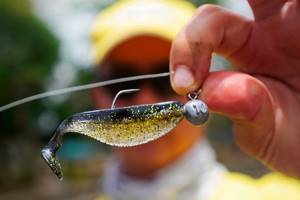
Classic Russian step wiring looks like this:
- Cast bait
- Hold the spinning rod so that its tip forms an angle of 45 degrees with the surface of the water
- Wait until the bait sinks to the bottom of the reservoir, as evidenced by the formation of sagging line and straightening of the tip of the spinning rod
- Make 1 to 3 turns with the reel handle, at this time the bait comes off the bottom and moves towards the angler, along an upward trajectory
- Make a pause, during which the bait hovers in the water column, sinking to the bottom; from the end of reeling to falling to the bottom should take from 2 to 5 seconds
- Repeat
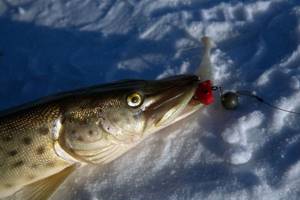
The speed at which the bait falls to the bottom depends on the mass and dimensions of the bait, the thickness of the cord, and the strength of the current. If the falling speed of the bait is too fast, you should reduce the weight of the jig head or cheburashka weight. If the bait's falling speed is too slow, the weight should be increased.
The main baits used with classic step fishing are vibrotails and twisters; slugs, worms and crayfish are less commonly used.
Short stepped wiring
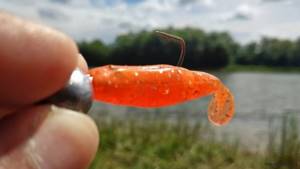
Short step wiring completely coincides with Russian classical step wiring, the only difference is a shorter step, which is done with only one revolution of the coil, but performed in a more frequent rhythm. Wiring is effective when fishing for passive fish; it works well for pike, pike-perch and perch.
American step wiring
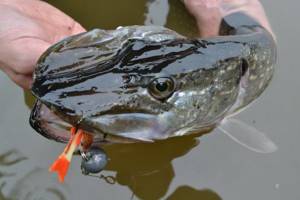
American step fishing is similar in principle to Russian step fishing, the only difference is that the step is performed not by rotating the reel handle, but by pulling the bait with the tip of a spinning rod.
First, several pulls are made with the tip of the rod, 20-30 cm each, then the slack of the cord is pulled out with a reel. The American version of step-by-step wiring is more labor-intensive, but more effective in terms of controlling weak bites that occur during a pause.
Wiring for demolition

Drift fishing is effective when fishing in the current. The bait is cast across the river flow. When the bait touches the bottom, the fisherman tears it off the bottom with a sharp swing of the rod, or 1-2 turns of the reel, the current carries it down in an arc, then touches the bottom again. The fisherman is reeling in a loose line. Wiring is carried out until the cord extends along the bank downstream. When using drift fishing, it is important to select the correct weight of the load so that the current can pull the bait, but it still touches the bottom when stopping.
Aggressive tossing
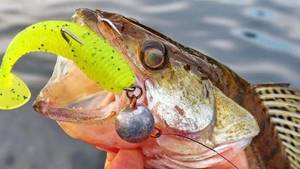
Aggressive tossing is used for catching active pike. After casting, when the bait touches the bottom, the rod is raised sharply upward, causing a sharp toss of the bait, followed by a pause, during which the bait falls to the bottom. The fisherman lowers the rod to a horizontal position and reels out the slack line.
Uniform wiring
Uniform retrieving is done by rotating the reel handle; winding is carried out at the same speed, without slowing down or accelerating, without pauses and without moving the spinning rod.
It makes sense to use uniform wiring when there is a lot of underwater vegetation, snags or debris at the bottom of the reservoir where fishing is carried out. In such places, if you fish with a classic jig step, there will be a lot of hooks and breaks of the bait, and uniform wiring allows the bait not to fall to the bottom and work in the water column, in the bottom layer.
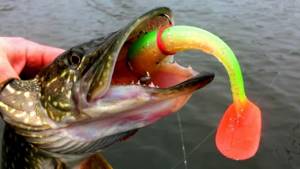
Uniform wiring is used only with silicone baits that have their own active game. A twister is ideal for uniform wiring.
During an even retrieve, the angler can adjust the depth at which the bait is located using the position of the tip of the spinning rod and the speed of reeling in the reel. When the rod tip is raised, the bait will go closer to the surface, when lowered closer to the water, closer to the bottom. When the reel rotates quickly, the bait rises closer to the surface; when it rotates slowly, it goes deeper. You can also adjust the depth of the bait by selecting the diameter of the fishing line and the weight of the load of the bait itself. With the help of even wiring you can catch pike, perch and catfish.
Wave-shaped wiring
Wavy retrieve is based on a uniform retrieve, but with the help of a reel or movement of the rod tip, the angler forces the bait to make wave-like movements in the water.
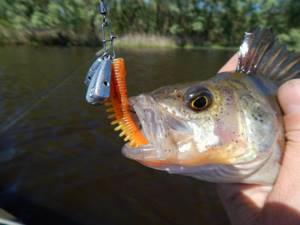
There are two ways to perform wavy wiring:
- A smooth, uniform reeling of the fishing line is carried out with a simultaneous smooth movement of the tip of the spinning rod up and down
- The line is reeled in smoothly with a reel with slowdowns, during which the bait drops lower, then reeling in with the reel is slightly accelerated, the bait rises a little higher
Pendulum wiring
Pendulum wiring is used in places with a heavily corroded bottom. With pendulum retrieving, the rod constantly moves up and down with a small amplitude while simultaneously reeling out the slack cord.
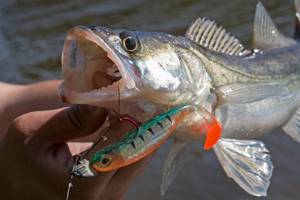
In order to perform pendulum wiring, you need to perform the following steps:
- Cast bait
- Let the load sink to the bottom
- Make a short, smooth pull with the rod up 15-20 cm, then lower the tip of the rod 5-10 cm down, while simultaneously reeling out the slack cord
- Repeat cycle
Dotted wiring
With dotted wiring, the bait drags along the bottom, moving with sharp movements of the rod tip with a small amplitude. The wiring is designed for catching pike perch.
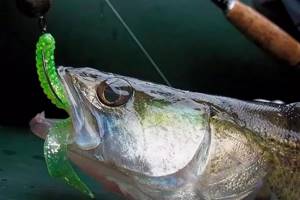
In order to perform dotted wiring, you need to perform the following steps:
- Cast bait
- Let the load sink to the bottom
- Using the tip of the rod, make neat small tosses of the bait by 5-10 cm, while simultaneously reeling in the sagging cord.
Retrieving the bait by dragging the bait along the bottom
Dragging along the bottom is used for catching passive fish. The advantage of this wiring is that the bait is located directly on the bottom and when the bait moves along the bottom, turbidity is formed, which additionally attracts fish.
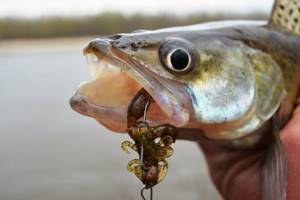
To fish with this type of fishing, you should use floating baits, which, in a calm position, take the position of a small fish standing with its tail up, feeding on the bottom. Particularly effective are silicone baits consisting of crayfish, cuttlefish, worms and nymphs. You should use a hinged mounting of the bait.
To drag the bait along the bottom, you need to place the tip of the spinning rod down, slowly rotate the reel handle, making stops while reeling in the fishing line. You need to be careful and ready to hook; bites most often happen at stops.
Jig fishing: wiring technique
The most important thing in jig fishing is the wiring technique, and then the baits used. In this article, we propose to briefly consider the main types of wiring used when jigging.
Fast (classic) wiring
It means active fast wiring using a coil. It starts when the bait touches the bottom. After several turns of the reel (from 2 to 6, with the length of the wire being 1.5-2 m), you need to take a short pause so that the jig sinks freely to the bottom. This pause should last from 1 to 5 seconds, 2 seconds is considered optimal. It is when the jig falls to the bottom that the fish most often grabs.
When the bait touches the bottom, you should continue retrieving until you reach the shore. During the fishing process, you can experimentally determine where the most bites are observed. The found area is fished more tightly.
Slow wiring
Slow retrieval is used when the bite is weak, as well as in cases where the horizontal movement of the bait provokes fish. The jig sinks to the bottom in 1-2 seconds, sometimes even less. The length of such wiring, like the classic one, is 1.5-2 m. Whenever possible, light weights (up to 7 g) are used for horizontal wiring. However, then it becomes more difficult for the fisherman to feel the ultra-light bait. Therefore, to carry out slow wiring, first master the classic wiring, which is considered the simplest.
Dotted wiring
Dotted wiring is used in jig fishing with long artificial worms (8-15 cm). This type of wiring is considered the most complex, but also the most effective in the complete absence of biting. Dotted wiring is carried out using a fishing rod installed in line with the fishing line. After lowering the jig to the bottom, the fisherman makes uniform slow pulls with the rod (10-15 cm each) with short stops.
Where to take the fishing rod - to the side or up - is determined depending on the direction of the wind and the specific fishing location. When the rod's stroke ends, you need to quickly reel in the line and the rod will return to its original position. With dotted wiring, the jig does not touch the bottom. After every 5-7 m of wiring, you need to look around to see if we have climbed too far. Perhaps it's time for us to stop and wait until the bait sinks to the bottom? If the lowering time exceeds 3-4 seconds, you need to reduce the speed of the retrieve and give the bait the opportunity to lie on the bottom more often. For example, not every 6-8 seconds, but every 1.5-2.
When jig fishing using dotted lines, you should not expect shock bites. Therefore, at the slightest suspicion of a fish touching the bait, immediately hook.
Pendulum wiring
The technique of such wiring is somewhat similar to vertical and dotted wiring, but it also has its differences. If with a dotted retrieve they make short pauses, then with a pendulum retrieve the rod is moved forward. In other words, after pulling 12-15 cm, the tip of the rod needs to be returned back 5-10 cm. A kind of Christmas tree emerges.
There have been cases when huge pikes were caught using pendulum fishing, in the absence of a bite when fishing with other techniques.
American wiring
This kind of wiring is similar to the classic one, but it is made not with a reel, but with a rod. When the jig touches the bottom, the fisherman makes a gentle pull of 1-2 m (depending on fishing conditions, in particular the length of the rod), selects a fishing line, etc. A short fishing rod will not make a long retrieve.
You can diversify the American wiring a little. For example, bring it closer to the dotted technique, do stretching no more than 50 cm. The stretching may or may not touch the bottom.
It seems that American wiring is not at all different from the “classics” in appearance. However, there are internal differences. So, with American wiring, the bait is led by hand, and the fishing line and jig seem to continue it. Classic coil wiring breaks this connection. It doesn't matter whether it's reductionist or not. When moving the reel, a noise is created that does not go away and scares away the fish.
Worm wiring
The worm wiring technique is very close to dotted wiring, but it uses heavier jigs. After each pull of 12-15 cm, the bait should touch the bottom. Worm wiring is considered effective, but requires constant attention and high technical training from the fisherman. The jig sinks to the bottom in 1 second. And during this small stop there follows a small blow that is not felt even by the hand. It can only be seen by the tip of the fishing rod.
Conclusion
Depending on the specific fishing conditions, fishermen often use combinations of different fishing rods. However, if you do not plan to catch all the fish in the pond, then it will be enough for you to master the classic and slow retrieve techniques. And we wish you a fun time and a good rest.
